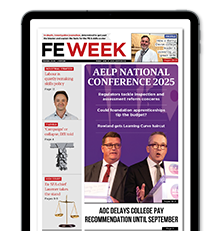The Department for Education has published the thresholds and eligibility criteria for its new ‘Covid workforce fund’ – but said colleges cannot make claims until next spring.
The fund was announced in November to help cash-strapped general, sixth form and specialist colleges pay for high staff absence rates, by meeting costs including bringing in supply teachers and paying additional hours for part-time teaching staff.
It covers the period November 1 to December 31 only.
Here is what you need to know from the new guidance…
1. Colleges need 45 cash days or fewer to be eligible
Sixth form and FE colleges will be eligible for the fund, the guidance reads, if they have an end of month cash position of 45 days or less at any point between November 2020 to March 2021.
Special post-16 providers will be eligible if their reserves at the end of March 2021 are no more than 4 per cent of their annual income.
The DfE warns funding can be clawed back through the assurance process if this criterion is not met at the year-end.
2. Use staff from different campuses if they are within an hour of each other
In addition to the cash days threshold, colleges are eligible if they experienced a short-term teacher absence rate at or above 20 per cent, or a longer-term rate of 10 per cent or above.
This new guidance elaborates that colleges can be eligible for payments for short-term absences on any given day, and can be eligible for payments for long-term absences if this has been the case for 15 or more consecutive days (excluding weekends).
Absences by permanent staff and staff employed on a long-term contract can be claimed for, and colleges should calculate their teacher absence rate at the level of the whole corporation, rather than for individual teachers.
For example, “a college experiences an absence rate of 15 per cent for 20 days, which then reduces to 8 per cent. The college could claim for up to 5 per cent for six days (for days 15 to 20)”.
If the college corporation is split up into different campuses, which are “within a reasonable travel time of each other,” which the DfE exemplifies as an hour by car, providers are expected “to consider options to use existing capacity across different sites to mitigate staff absence, before considering additional staffing spend”.
The DfE has told colleges to avoid double claiming for the same absences against the long-term and short-term rates.
Absences by support staff will be eligible “on an exceptional basis” if those staff are directly involved in education, or involved in duties such as cleaning, catering staff, transport, IT or if they are estates staff.
For special post-16 providers to claim, their short-term rate is for total teacher and leader absences at or above 15 per cent on a given day; their long-term rate is the same as FE and sixth form colleges. Support staff thresholds are the same as teaching staff thresholds.
Claims by specialist providers can be made “for roles which are necessary for maintaining critical provision for students, where the institution certifies that these roles cannot otherwise be managed using existing staff and resources,” the guidance reads. Providers must show they have tried to mitigate the absences.
3. What sort of assurance will be involved?
Colleges should keep records of all expenditure relating to staff absence and keep records to show support staff are eligible for funding.
The college leader who submits the claim must certify the claim is fraud and error-free, and their provider must identify this income and confirm it was appropriately used in their accounts.
4. What else do colleges need to evidence?
In addition to the above, colleges also need to show they were open for on-site delivery in the days in question, are not claiming costs from an existing insurance policy.
5. But colleges will not be able to claim funding until spring 2021
Although the DfE has restricted this funding to colleges “facing significant funding pressure,” the guidance released today says: “Colleges will be able to make claims for costs eligible for reimbursement through this fund in spring 2021.
“We will publish detailed guidance about the claims process then.”
Meaning colleges already running short of cash will have to bear the weight of staff absence costs for another three months at least.
The DfE has highlighted, though, that colleges will continue to receive their core funding allocations.
The 16 to 19 tuition fund, a £96 million pot which colleges can use to help students catch-up on education, has been used by some providers to hire extra teaching and pastoral staff. But the DfE has insisted in the new guidance: “Colleges must not divert this funding to help meet with the costs of staff absence.”
Colleges also cannot claim for training or other incidental staff-related costs; increasing part-time staff pay unless there is an increase in responsibilities as well; cover for absences where teaching or training is delivered commercially; or for capital costs for staff delivering education remotely.
Providers must be “financially prudent when sourcing cover,” the guidance adds.









Your thoughts